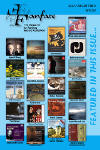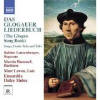Texte paru dans: / Appeared in:

Fanfare Magazine: 36:6 (07-08/2013)
Pour
s'abonner / Subscription information
Les abonnés à Fanfare Magazine ont accès aux archives du
magazine sur internet.
Subscribers to Fanfare Magazine have access to the archives of the magazine
on the net.
Naxos
NAX8572576

Code-barres / Barcode : 0747313257676
We just heard the first disc devoted entirely to this 15th-century manuscript (Fanfare 36:2). As we saw before, the name given to it when it was first examined in 1874, “The Songbook from Glogau,” is not accurate, for it is a set of three part-books containing mostly Latin sacred music and untexted melodies. Hence more recently Leeman Perkins suggested calling it “The Glogauer Part-books.” Removed from the former Berlin royal library during World War II, it ended up at the Jagiello library in Cracow. Since Glogau (Silesia) is now in Poland, it appears that returning it to Berlin is not under consideration. Of the 292 selections, eight of them are duplicated in both recordings.
While the texts and translations must be downloaded from a website, unlike the previous issue, this booklet does have a very informative note with comments on each selection. For one thing, it explains the subtitle of the disc, “Songs, Comic Tales and Tails,” the “tails” (Schwanzen) being dances. The subtitle indicates that the selection ignores the sacred music that predominates in the collection. The limitation is not quite accurate, for the opening selection is “Christ ist erstanden,” the Easter sequence and the oldest sacred song in the collection. The two singers, both as soloists and in duet, are pleasant and the five players of the ensemble, including Marc Lewon, apparently first among equals, use modern copies of period instruments. The playing is restrained, the program flowing easily from instrumental to vocal pieces. Some of the music is widely known in Western Europe, so concordances consulted are listed, including Buxheimer, Petrucci’s Odhecaton print, Cordiforme, and Trent 89.
The sound of this ensemble is distinctly different than Clemencic’s, for the latter includes the prominent sound of a cornett in a non-alta capella ensemble and a positive organ. His three singers (there are, after all, three part-books) are placed more forward than their counterparts on this disc. Specialists will certainly want both discs after waiting so long, but a more casual collector will be satisfied with the Naxos disc. It ignores the predominance of sacred music, but it is a very pleasant listening experience, either for study or for more casual use.
Cliquez l'un ou l'autre
bouton pour découvrir bien d'autres critiques de CD
Click either button for many other reviews


